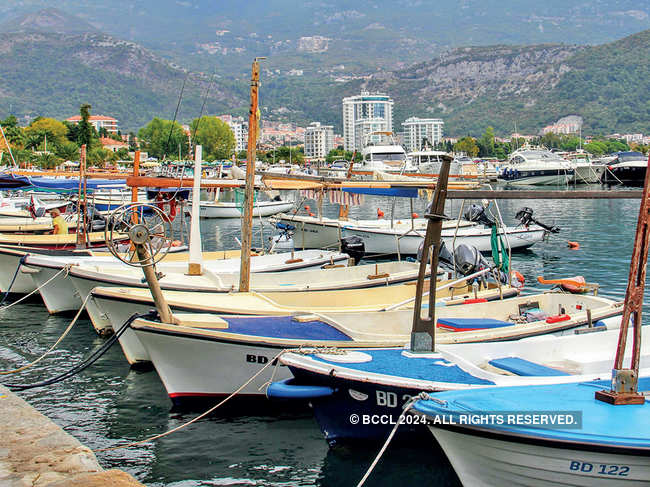
The UNESCO Heritage city is the coastal heart of Montenegro, a small Balkan nation nestled between Croatia, Serbia and Albania, with a striking diversity of terrain and climate.
Down the ages, Montenegro has been ruled by the Romans, the Hungarians, the Venetians and the Ottomans and has suffered from break-up of the Yugoslavia. Today, many call it the “new French Riviera”.
I have driven here from Dubrovnik in Croatia, crossing borders effortlessly into a stunning landscape of tall mountains and a deeply indented coast with mini fjords and walled cities.
“Montenegro has always been a glitzy place attracting celebrities with their yachts. Today, it is a major port for cruise ships,” says Marina.

We first explore Budva, a town founded by the Greeks in the 4th century. Its marina is peppered with yachts of the rich and the famous and Venetian-style medieval fortifications encircle the old town. There are grey stone houses with red terracotta roofs and entrances leading to pebbled beaches with loungers.
At one end of Budva is a citadel where the annual theatre festival is held. The square in front has four churches. I walk past artists painting on easels and stalls selling souvenirs to the Orthodox Holy Trinity Church, which is adorned by stripes of pink and honey stone and frescoes. We then drive to Kotor, encircled by ancient ramparts and moats.
The town used to be a prosperous outpost of the Venetian Empire. Today, many of the flamboyant mansions have been turned into boutique hotels. Centuries of Venetian domination has given Kotor a collection of museums, old pharmacies and Roman Catholic and Eastern Orthodox churches.
I walk through the town paved in marble and limestone, criss-crossed with a maze of narrow cobblestone streets and alleys lined with houses with green shutters. One street is so narrow it is called Pušti Me Pro (Let Me Pass)!

“The confusing layout acted as a protection from intruders,” says Marina. A street musician plays a brisk tune on his accordion as a bearded Greek Orthodox priest in black robes walks towards the tiny church.
Legions of cats linger about sunning themselves, as tourists with gelatos in hand click away the scenes unfolding before them, and church bells chime in the distance. The town is proud of its motley band of cats, probably descendants of those that migrated from ships that came to shore over the centuries. There is even a museum devoted to them, and a square named after them. Kind tourists make sure they are fed!
I walk through shady palazzos and irregular squares with fountains. Each square offers a mish mash of architectural styles and most are named after their former use — like Milk Square and Flour Square.
Many of Kotor’s buildings have arches and balconies and the white stone buildings have been hewn from nearby mountains and cliff-sides. The town’s old clock tower leans slightly, an effect of past earthquakes.
The sea has always been a part of the life here. We peek into the Maritime Museum fronted by two cannons to know Kotor’s seafaring past – this is a treasure trove of maps, navigational instruments, model ships, gleaming cutlasses and ivory figurines.
I walk through an open-air market where stalls offer air-dried ham, olives and garlands of dried figs alongside lace tablecloths.
Restaurants do brisk business serving seafood — grilled sea bass, grilled octopus drizzled with olive oil, salted sheep’s cheese, monk fish and squid alongside homemade rakija — a fermented plums and grapes brandy.

We walk through the serpentine streets and end up at St Tryphon’s Cathedral dating back to 1166. The dark and candlelit interiors have ancient Greek frescoes and a gold altar.
Local legend has it that Venetian merchants were sailing carrying the relics of St Tryphon — a third-century saint. Because of bad weather, they took refuge in Kotor. But every time they attempted to set sail, the weather turned stormy. So they read this as a message that the saint’s remains should stay back in Kotor.
My favourite church is St Luke’s, built in 1195, which is an example of religious tolerance. In the 17th century, the Catholics turned it over to the Orthodox Church but retained the right to have an altar. I gaze at faded wall frescoes and the altar gilded in gold. But there are no pews. My guide says this is because Orthodox Christians stand during services. The dead were buried beneath the floor until the 1830s.
Behind the cathedral, the defensive walls — nearly five km long — snake up the rocky hillside with ramparts, towers, citadels, bastions and gates to the 14th century fortress of St Ivan. “It is a kind of mini Great Wall of China,” says the guide.
The 20-metre high walls have been indestructible — even earthquakes have spared them. Kotor also prides itself on never having been taken by force. There is an inscription above the Northern Gate that refers to how, in the 14th century, Turkish general Hayreddin Barbarossa besieged Kotor with a great naval force but was still unable to conquer the town.
I sit at a café munching on local biscuits covered with chocolate cream and sipping on espresso, watching the sunset paint the stone buildings a burnished orange, silhouetted against the granite grey of the surrounding cliffs and the blue waters of the Adriatic. As a cruise ship leaves town, the town goes back to its tranquil self: shutters come down and the locals retire to their homes. I can hear the distant strains of a piano, and it is easy to imagine the Montenegro of long ago.











 Get Unlimited Access to The Economic Times
Get Unlimited Access to The Economic Times
